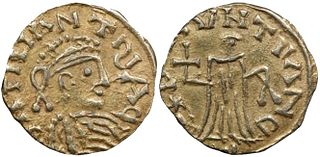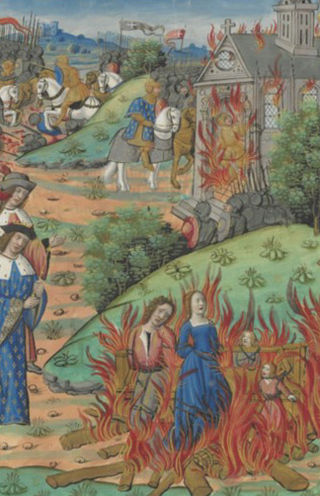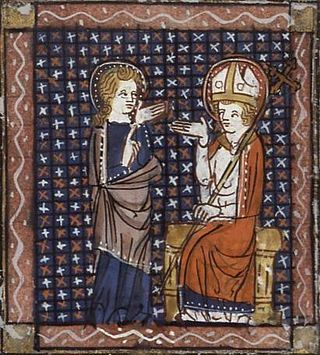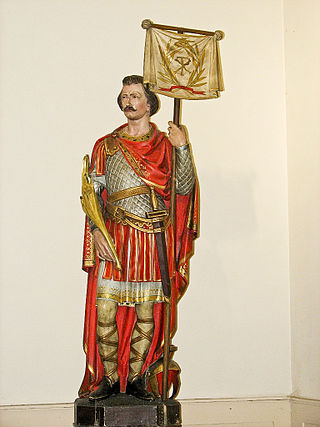Related Research Articles

Clovis was the first king of the Franks to unite all of the Frankish tribes under one ruler, changing the form of leadership from a group of petty kings to rule by a single king and ensuring that the kingship was passed down to his heirs. He is considered to have been the founder of the Merovingian dynasty, which ruled the Frankish kingdom for the next two centuries. Clovis is important in the historiography of France as "the first king of what would become France".

Pope Gregory VII, born Hildebrand of Sovana, was head of the Catholic Church and ruler of the Papal States from 22 April 1073 to his death in 1085. He is venerated as a saint in the Catholic Church.

Gregory of Tours was a Gallo-Roman historian and Bishop of Tours during the Merovingian period and is known as the "father of French history." He was a prelate in the Merovingian kingdom, encompassing Gaul's historic region.

Chlothar II, sometime called "the Young", was king of the Franks, ruling uled Neustria (584-629), Burgundy (613-629) and Austrasia (613-623).

Clermont-Ferrand is a city and commune of France, in the Auvergne-Rhône-Alpes region, with a population of 146,734 (2018). Its metropolitan area had 504,157 inhabitants at the 2018 census. It is the prefecture (capital) of the Puy-de-Dôme département. Olivier Bianchi is its current mayor.

Chlothar I, sometime called "the Old", also anglicised as Clotaire, was a king of the Franks of the Merovingian dynasty and one of the four sons of Clovis I.

Gaius Sollius Modestus Apollinaris Sidonius, better known as Sidonius Apollinaris, was a poet, diplomat, and bishop. Born into the Gallo-Roman aristocracy, he was son-in-law to Emperor Avitus and was appointed Urban prefect of Rome by Emperor Anthemius in 468. In 469 he was appointed Bishop of Clermont and he led the defence of the city from Euric, King of the Visigoths, from 473 to 475. He retained his position as bishop after the city's conquest, until his death in the 480s. He is venerated as a saint in the Catholic church, with his feast day on 21 August.

Saint Gontrand, also called Gontran, Gontram, Guntram, Gunthram, Gunthchramn, and Guntramnus, was the king of the Kingdom of Orléans from AD 561 to AD 592. He was the third-eldest and second-eldest-surviving son of Chlothar I and Ingunda. On his father's death in 561, he became king of a fourth of the Kingdom of the Franks, and made his capital at Orléans. The name "Gontrand" denotes "War Raven".
Brunhilda was queen consort of Austrasia, part of Francia, by marriage to the Merovingian king Sigebert I of Austrasia, and regent for her son, grandson and great-grandson.

Chram was the son of Chlothar I, a Merovingian king of the Franks, and his fifth wife, Chunsina.

Brice of Tours was a 5th-century Frankish bishop, the fourth Bishop of Tours, succeeding Martin of Tours in 397.

The Diocese of Gap and Embrun is a Latin Church ecclesiastical territory or diocese of the Catholic Church in Provence-Alpes-Côte d'Azur region of Southern France.

Saint Nicetius was a bishop of Trier, born in the latter part of the fifth century, exact date unknown; died in 563 or more probably 566.

The Roman Catholic Archdiocese of Toulouse is an ecclesiastical territory in France. The diocese comprises the Department of Haute-Garonne and its seat is Toulouse Cathedral. Archbishop Guy de Kerimel has been its head since 2021.

The Roman Catholic Archdiocese of Clermont is an archdiocese of the Latin Church of the Roman Catholic Church in France. The diocese comprises the department of Puy-de-Dôme, in the Region of Auvergne. The Archbishop's seat is Clermont-Ferrand Cathedral. Throughout its history Clermont was the senior suffragan of the Archdiocese of Bourges. It became a metropolitan see itself, however, in 2002. The current archbishop is François Kalist.
Saint Gal of Clermont was the sixteenth Bishop of Clermont, holding that see from 527 to 551. He shares a name with a later bishop of the diocese, who, though less illustrious than the first Gal, is also revered as a saint. Gal played an important role in the politics of the Church, as the Council of Clermont (535) was hosted under his episcopate. He was the uncle and teacher of Gregory of Tours.

Saint Julian of Brioude (†304) was a legendary martyr and saint from the Auvergne region of France. Although the main focus of his cultus was in the small village of Brioude, he was originally from the city of Vienne, and also associated with Clermont. He was most famous through his association with an aristocratic family of bishops of the time, his most notable proponents being St. Gallus of Clermont and St. Gregory of Tours. Gregory wrote a vita of Julian, but his attempts to expand the saint's cult from the Auvergne to Touraine and Aquitaine were unsuccessful, and Julian is now only remembered through his basilica in the town of Brioude itself.
Heraclius was Bishop of Angoulême. The main source about his life is the Historia Francorum of Gregory of Tours.

Apollinaris was a count of Auvergne who led a auvergnat army for the Visigoths in the Battle of Vouillé, and was bishop of Clermont for four months before his death.
Avitus was a bishop of the Diocese of Clermont in the 6th century. He is recognized as a saint in the Catholic and Orthodox churches. His feast day is on August 21st.
References
- ↑ A History of the Franks, Gregory of Tours, Pantianos Classics, 1916
- ↑ Histoire résumée et chronologique des persécutions contre les Juifs de l'Antiquité au Moyen Âge - de la Colonisation romaine de la Gaule aux premiers Capétiens